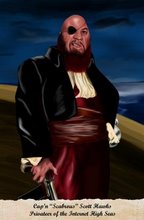I had turned my weed eater over to fix the spline when the thing buzzed my head. Not cool. I panicked for a second, dropped the weed whacker, and retreated. The gigantor wasp, two inches if it was an 1/8th, backed off for a second too. I took the opportunity to rethread the weed eater and brandished it Texas Chainsaw Massacre style at the mammoth bug. I spun the spline at it a couple of times, hoping more to scare it away than do any real damage, though I wouldn't have been averse to seeing some dismemberment as well. No bug gets the best of me in my yard! The huge wasp zipped out of the yard after a couple of close calls with the weed eater. In retrospect, I was lucky that it was the particular breed it was, considering yellow jackets and hornets are aggressive and probably would have stung my ass a few times extra for good measure.
I wrapped up my weed killing before the B2 of wasps made its way back so I headed inside to do some research. Turns out my adorable little friend is none other than the Sphecius speciosus, or the Eastern Cicada Killer. This little feller is solitary as opposed to social, which means that it will not attack a human unless handled roughly, even to defend its burrow. Further more, the only ones to actively investigate people are males, ensuring that we're not other males encroaching on territory or a female ready to mate, I assure you, I was neither. However, even then, males can't sting, they can just poke with their sharpened tails.
The females create the burrows, paralyze cicadas and other insects, plant them in a chamber in the burrow, and then deposit an egg with the victim. The egg hatches over the summer and the larva overwinters in a cocoon after feeding off the cicada. Matter of fact, that image up nort' there is of a female cicada killer bringing a victim back to her burrow. Interestingly enough, it's not alive, but posed that way by one Professor Chuck Holliday (with a name like that, what's he doing outside of a recording studio?) from whom I got most of my cicada killer knowledge. Sure, there's a Wikipedia article, but I found his information, not to mention extensive picture and movie collection of the monster wasps much more enlightening.
They're fascinating bugs, but I'd rather not have them buzzing me when I'm out in the yard. You never know what batch of radioactive nuclear waste it was floating in earlier.
 Just an example of a burrow, nothing to scale, but that hole is big enough to toss a dwarf down.
Just an example of a burrow, nothing to scale, but that hole is big enough to toss a dwarf down. Here's a smaller wasp hitching a ride on Professor Chuck's hand after an exhausting cicada killing.
Here's a smaller wasp hitching a ride on Professor Chuck's hand after an exhausting cicada killing.Thanks to Professor Chuck HOLLIDAY (what a frickin' sweet name) for all the cicada killer lore. Check out his excellent site on the subject if you're curious at http://ww2.lafayette.edu/~hollidac/cicadakillerhome.html


1 comment:
The closer image of killer wasp looks scary, as the name itself speaks! Thanks for sharing your knowledge about these wasp, this is indeed helpful esp. those who have experience attacks from them.
Check out How to Get Rid of Wasps Safely and Effectively
Post a Comment